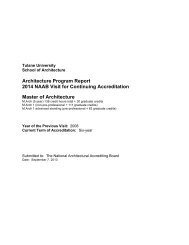Architecture Program Report Tulane University New Orleans ...
Architecture Program Report Tulane University New Orleans ...
Architecture Program Report Tulane University New Orleans ...
You also want an ePaper? Increase the reach of your titles
YUMPU automatically turns print PDFs into web optimized ePapers that Google loves.
SUPPLEMENTAL INFORMATION"<br />
DESCRIPTION OF PROCEDURES FOR EVALUATION<br />
STUDENT TRANSFER CREDIT AND ADVANCED PLACEMENT<br />
Admission<br />
All undergraduate admissions to <strong>Tulane</strong> are managed by the <strong>University</strong>’s<br />
Office of Admissions. The School of <strong>Architecture</strong> does not undertake a<br />
separate admissions process for undergraduates. However, the School<br />
reviews admissions and works closely with the Admissions Office to<br />
select the most promising candidates. All graduate admissions to the<br />
Master of <strong>Architecture</strong> I and II, as well as the Preservation <strong>Program</strong> are<br />
administered through the School of <strong>Architecture</strong>. The School looks<br />
closely for intelligence, creativity, motivation, achievement, leadership,<br />
and character. Academic potential is essential. At the same time, the<br />
School seeks students who exhibit energy and the ability to contribute to<br />
campus life outside the classroom. In addition, we believe that diversity<br />
among students is a great educational enhancement and therefore seek<br />
and admit students from varied backgrounds.<br />
FROM SECONDARY SCHOOL PREPARATION<br />
Students should consult with the <strong>University</strong>’s Office of Admissions to<br />
learn about the requirements and processes of admissions at <strong>Tulane</strong>. In<br />
general, <strong>Tulane</strong> seeks students who have a strong high school academic<br />
record in terms of performance (grades and class rank, if available) and<br />
selection and content of courses studied. <strong>Tulane</strong> recognizes that<br />
curricula vary among high schools and that not all students have the<br />
same academic resources available to them. The Admissions office does<br />
look, however, for students who undertake the most challenging college<br />
preparatory program possible. Applicants are evaluated in terms of how<br />
well they use the resources available, and the Admissions office also<br />
takes into consideration the differences in grading standards that exist<br />
between schools.<br />
A solid secondary school program should emphasize the traditional<br />
college preparatory subjects and include at least four courses each year<br />
selected from English, mathematics, foreign languages, science, social<br />
studies, and art. An effective college entrance program should include:<br />
• English–four years with extensive reading and writing.<br />
• Mathematics–preferably three years; calculus is desirable.<br />
• Foreign Languages–at least two and preferably three or four years of a<br />
classical or modern language; three or four years of one language are<br />
generally preferable to two years each of two languages.<br />
• Science–at least two years of laboratory science; physics is especially<br />
recommended for architecture applicants.<br />
• Social Studies–at least two years, with emphasis on history.<br />
• Studio Art–at least two years, preferably freehand drawing.














